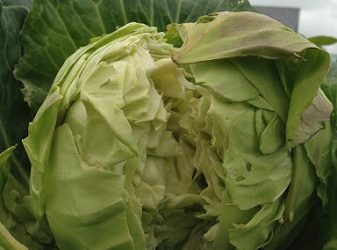
Often, cabbage seedlings dry out when improperly maintained. In this case, you need to act immediately, because the symptoms of dangerous diseases appear.
In order that the leaves do not fade , the main mistakes should be avoided during sowing and transplanting. The leaves of cabbage seedlings dry for the following reasons:
– High temperature and dryness ear In hot conditions, the seedling withers, and the leaves on the stem dry. Sprouted containers are grown at a temperature of 10 ° C to 20 ° C.
– Insufficient amount of light. Cabbage needs exposure to direct sunlight. Thanks to good lighting , the bush grows and hardens much faster.
– Sour soil. Due to improperly selected soil, the plant may become ill. A vegetable crop needs a clean and fertilized land with neutral acidity. Suitable soil for cultivation is soil based on sterile peat or coconut.
– Improper watering. Young bushes require abundant, timely and regular watering.
– Poor prevention and treatment of the bush. So that the seedling does not hurt, and the bush does not sluggish, it is imperative to follow the proportions in the calculation of the solution when feeding the soil or root system.
– Transplanting to a permanent place in the garden. During planting in open ground, some of the roots are noticeably damaged. This is the reason for the yellowing of the seedlings. After 5-6 days it will take root and will gradually grow.
Any stressful situation for the bush causes yellowing in its lower part.
Drying due to a pest
Cruciferous fleas are considered the main insects that harm the vegetable culture. This type of beetles is distinguished by jumping ability and a brilliant body. Parasites harm young cauliflower. The leaves on it become openwork, curl and fall off.
To get rid of insects, it is necessary to treat the bush with chemical preparations or solutions prepared at home. The best remedies for cruciferous fleas are:
– Intavir, Bankol. They are prepared according to the attached instructions, use no later than 20 days before harvesting.
– A solution of vinegar. Mix vinegar of 9% concentration with about 2 tbsp. l 10 l of water.
– Tomato tops.To do this, 4 kg of stepchildren, 1 kg of dry tops are mixed with 10 liters of cold water and insisted for 4-5 hours, then heated, then cooled, diluted in half with water and sprayed seedlings in the morning or in the evening.
– For pollination use ash, tobacco dust or black pepper. When processing with these tools, they must wear a mask, and eyes – glasses for protection. Spraying is carried out with a mixture volume of 50 g per 10 square meters. m.
One of the commonly used methods against cruciferous fleas is glue traps. Thanks to the glue on the shields, the pests stick and remain trapped. Also, fleas do not like wet soil, so beds are recommended to be watered more often.


